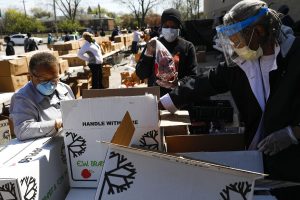The weekend before New York City’s stay-at-home order went into effect, my 15-year-old daughter and I had an argument. She asked if she could hang out with friends in our neighborhood, promising to “be very careful” and “bring Purell.” Acknowledging the necessity of friends and fun, I said yes and sent her off.
I went for a run and texted her as I was getting back. I looked up from my phone to see her on a stoop half a block away. There she sat, shoulder to shoulder with a friend, the picture of good clean fun. On any other occasion, the sight would have warmed my heart. Not that day. I panicked and reprimanded the kids as though I had just stumbled upon them passing a joint.
My daughter waited until we were alone to strike back.
“You’re so embarrassing! You’re crazy,” she said.
These are words every mother of a teen has probably heard. “I’m sorry,” I said. “These are strange times. I need you to be safe.” Another familiar line.
Then, something new happened.
She reached for my hand — and I confess, in that moment, I recoiled. I did not know if she was offering her hand to reconcile or retaliate.
Normal had pulled a U-turn. An affectionate gesture was now a potentially harmful act. In one seismic quake, coronavirus shifted the stakes of teenage rebellion and parental control. Whereas a fight over curfew or responsible partying always addressed serious consequences in abstract, for most teenagers, breaking the rules had not before been so clearly a matter of life and death.
My Quaranteen is having a more intense experience than her younger brothers, who are 12 and 7. (She knows I’m writing about this.) Like most families, we spent the last month at home, staying safe — and sane. While my younger kids adapted more readily, my daughter adapted in fits and starts. Quarantine turned up the heat on the fraught mother-daughter relationship, intensifying conflict. Think pressure cooker. With black market firecrackers. Living with an invisible outside threat, and no visible outlet, forced my daughter and me to negotiate and reconcile — and fast.
Reminders to wash hands were initially met with scorn. Our occasional walks ended in tears. When I handed her gloves and a mask, she acted like a toddler refusing to wear her winter coat. For me, it felt as if she wanted to ride a motorcycle with no helmet. For her, it must have felt as if I was grounding her for months, which, of course, I was.
Tele-school had a cooling effect on the dynamic. Technology morphed from diversion to the very forum for education. Eavesdropping on classes was a treat. Her history teacher lectured on examples of states checking federal power. A math teacher designed algebra problems using health stats. It’s impossible not to see tele-school, and the sudden proliferation of Zoom congregations, digital workouts, recipe sharing and D.I.Y. tips as a kind of renaissance. Now, my teen can say “I told you so” to every complaint I’ve lodged. The technology that had pervaded the lives of Gen Z was suddenly earning its keep.
Technology stoked creativity too. My daughter tie-dyed sweatsuits, using household bleach. She made gnocchi from scratch. She and her friends popped up a virtual salon, dying their hair pink, followed by a movie marathon. The upper body movement of TikTok dances almost counted as exercise. Once, I found her applying coffee grounds and Vicks VapoRub to her belly, Saran-Wrapping the mixture for safe keeping, a beauty product she claimed would do the work of a workout. Technology brought the Quaranteen full circle, proving you can do almost anything at home — and providing that coveted illusion that a teen can do everything herself.
Already a generation conditioned to social distance with phones, teenagers are now finding that their devices are life lines to the old social lives they’ve suddenly lost. The physical restrictions reveal teens’ innate need to be together, a need as intrinsic to their survival as water. They now have to contend with the usual flurry of moods that buffet teenagers on a good day — without friends, and worse, confined with the very people they yearn to escape, their parents. It amounts to a teen’s worst nightmare.
I’ve heard from many parents that teens are cycling through moods ranging from rage to despair. But could this experience, and these adaptations, reap changes worth keeping around?
If the adolescent brain is prone to feeling immortal, it follows that teenagers are particularly dogged by a situation so fraught with death. For teens, a demand to remain six feet apart, and ultimately, to stay indoors for weeks, is a kind of death. I may as well have said, “No, you cannot see boys.” “No, you cannot go to parties.” “No, you cannot be a grown-up yet. You must follow my rules for the indefinite future and abide by the same rules as your 7-year-old brother.’’
For my daughter, that makes me the personification of her captivity and, in some weird sense, the virus. I am easier to blame than something she could not see. No matter that I am and always will be the person most concerned with keeping her safe. This means I now also have two antagonists — the virus and my daughter.
This story has no poignant resolution. We have not yet done a digital workout class together. We have not made sourdough bread. But there have been signs of light. She made her brothers a much appreciated Nutella pizza. She has played the occasional game of Uno. She has even begun to join my nightly ritual, watching Rachel Maddow on the living room sofa, agreeing that Governor Cuomo is cool. When I felt not great the other morning, she made me a whipped coffee drink.
Parenting a teen isn’t easy — even in the best of circumstances. It is a battle with three losers, the mother losing her grasp on her soon-to-be adult, the child rejecting the mother’s rules, and the once-inextricable bond, often shredded temporarily. Best case: The daughter gains independence, the mother grieves the loss of control, and the relationship re-forms. Right now, we’re playing for quiet coexistence. Maybe, as time passes, as we each accommodate the other’s challenges, and grieve losses we all share, my daughter and I will find each other again. If only in gratitude and respect for how we coped.
Someday soon, I hope, we will hold hands again carelessly. Or maybe just sit on the sofa, shoulder to shoulder.
“Don’t be cheesy, Mom,” she will say. But we will be side by side.
Galt Niederhoffer is a writer and film and television producer.






















